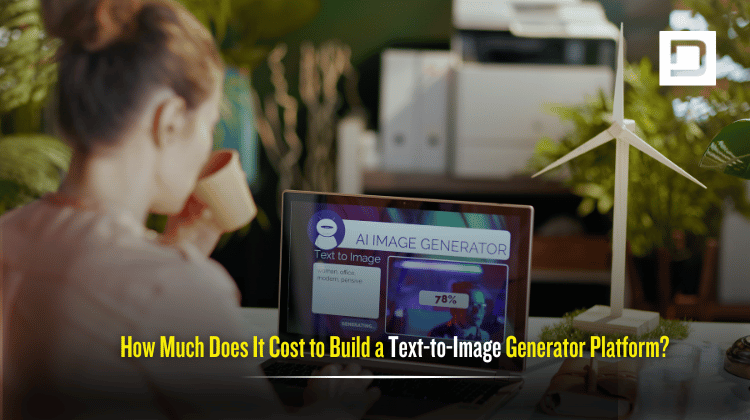AI Image Generator Software Development Guide: From Prompt to Pixel
In the last few years, artificial intelligence has transformed how businesses operate, create, and innovate. Among these revolutionary changes, AI Image Generator Software Development has emerged as one of the most impactful innovations across industries. The ability of machines to transform simple text prompts into detailed, realistic images has opened limitless opportunities from marketing and design to healthcare, education, and entertainment.
If you are a business leader, product owner, or startup founder exploring the potential of AI Image Generator Software, this blog will serve as your ultimate roadmap. We’ll walk you through the journey of AI Image Generator Software Development right from understanding prompts to finally generating stunning, pixel-perfect output.
By the end of this guide, you will not only grasp the technical and business aspects of this transformative software but also gain insights into why partnering with Depex Technologies is the best strategic decision for your AI product journey.
Understanding AI Image Generator Software
At its core, AI Image Generator Software is a specialized application that uses artificial intelligence to create images based on input prompts. A user provides a textual description (for example: “a futuristic city skyline at night with flying cars”), and the AI produces realistic or stylized images that match the description.
These software systems leverage advanced machine learning models, particularly deep learning architectures like Generative Adversarial Networks (GANs) and diffusion models, to generate new visual content that has never existed before.
In simple terms: AI Image Generator Software Development is about engineering intelligent models and platforms that turn imagination into visuals. The expertise lies not just in building neural networks but also in creating an intuitive, scalable product that solves real-world business challenges.
Evolution of Image Generators: From GANs to Diffusion Models
The journey of AI image generation has been extraordinary:
- Early GANs (2014–2017): Generative Adversarial Networks brought the ability to generate synthetic images, but they struggled with low resolution and stability.
- Progressive GANs (2018): These offered higher quality images, especially for faces.
- StyleGAN (2019): Revolutionized AI-based face and art generation with unmatched realism.
- Diffusion Models (2020 onwards): Newer models like DALL·E 2, Stable Diffusion, and MidJourney rely on iterative denoising methods to create sharper, more controlled results.
As of 2025, Diffusion Models dominate the industry, providing scalable, controllable, and reliable outcomes. A successful AI Image Generator Software Development project must embrace these modern advancements while staying flexible to accommodate future innovations.
Key Features of AI Image Generator Software
When envisioning AI Image Generator Software, the following features are essential:
- Text-to-Image Generation: Core functionality where natural language prompts become images.
- Style Transfer Options: Ability to generate images in different artistic or photographic styles.
- Image Editing Tools: Inpainting, background removal, and object replacement to refine outputs.
- Resolution Scaling: Options for HD, 4K, and custom resolutions.
- Prompt Customization: Keyword weighting, constraints, and advanced prompt structuring.
- API Integrations: For embedding AI generation in SaaS platforms, mobile apps, or creative tools.
- Secure Cloud Hosting: Data privacy, compliance with GDPR, and enterprise-level security.
- User Accessibility: Easy-to-use dashboards for non-technical users.
Building feature-rich AI Image Generator Software ensures that the solution isn’t just powerful but also usable and adaptable across industries.
The Development Lifecycle of AI Image Generator Software
Developing AI Image Generator Software requires a structured, multi-phased approach. Let’s explore step by step.
Ideation and Market Research
Before code is written, thorough market research ensures the software caters to the right audience. Questions include: Who will use this tool—businesses, designers, or individual creators? What unique gap will your AI Image Generator fill? What platforms will it serve (web, mobile, API)? This step also includes competitor analysis to identify gaps and differentiators.
Data Collection, Cleaning, and Augmentation
High-quality data is the foundation. Model performance depends on diverse, labeled, and bias-minimized datasets. Public datasets like LAION-5B, COCO, and proprietary image-text pairs form the training base. Data cleansing removes irrelevant, duplicated, or poor-quality samples. Augmentation adds variety—through cropping, color shifts, and synthetic image-text pairing—to improve generalization in model outputs.
Selecting the Right AI Architecture
Choosing between GANs, Variational Autoencoders, and diffusion models is critical. Currently, diffusion-based frameworks like Stable Diffusion provide superior flexibility and quality. The choice also depends on use-case specifics—GANs are faster at inference but diffusion models can create more coherent images from complex prompts.
Model Training and Optimization
Training large-scale image generation models requires powerful GPUs or TPUs, distributed training strategies, and algorithmic optimizations like mixed precision training and gradient checkpointing. Fine-tuning pretrained models on domain-specific data can accelerate development while improving relevance. Post-training optimizations—such as quantization and pruning—help reduce the model’s size and inference time without sacrificing quality.
Backend and Frontend Development
A scalable backend handles user requests, manages concurrency, performs inference on GPUs, and delivers images rapidly. Common backend technologies include Python-based frameworks (FastAPI, Flask), container orchestration (Kubernetes), and cloud services (AWS/GCP/Azure). The frontend UI must balance simplicity and power, offering prompt input, style selection, and preview features with clean design to ensure broad user adoption.
Integration of Prompt-to-Pixel Workflow
This critical step tightly couples the AI model pipeline with the user interface. It involves prompt parsing, preprocessing, model inference, postprocessing, and image delivery. Optimizations for latency are essential to create seamless user experiences—caching, asynchronous processing, and load balancing often play roles here.
Testing and Quality Assurance
Beyond traditional software testing, AI models require specialized evaluation. This includes: automated metrics (FID score, Inception Score), human evaluations for relevance and creativity, and safety filters to detect and block inappropriate content. Continuous retraining cycles using user feedback and error logs help maintain and improve quality over time.
Deployment and Scaling
Cloud-native deployment enables auto-scaling for varying traffic loads. Using containerized environments and serverless functions ensures cost efficiencies. API rate limiting, logging, and monitoring tools help maintain reliability and security while allowing growth for millions of concurrent users.

Core Technologies Behind AI Image Generators
Developing advanced AI Image Generator Software requires a stack of cutting-edge technologies:
- Machine Learning Frameworks: TensorFlow and PyTorch are the most popular for building and training neural networks. Their support for GPU acceleration and vast libraries of pretrained models aid rapid development.
- Cloud Infrastructure: Platforms such as AWS SageMaker, Google AI Platform, and Azure Machine Learning streamline training, deployment, and scaling.
- APIs and SDKs: RESTful APIs enable easy integration into client-facing applications; SDKs enable mobile and desktop app embedding.
- GPU/TPU Acceleration: Specialized hardware accelerates the model training and inference phases, significantly reducing turnaround times.
- Natural Language Processing (NLP): Proper understanding of user prompts is key. Embedding models like CLIP map text to image features to ground the generation process consistently.
Business Applications of AI Image Generator Software
The scope is vast and spans multiple industries:
- Marketing & Advertising: Quickly generate high-quality, customized creative assets for campaigns, banners, and product visuals without expensive photoshoots or graphic designers.
- E-commerce: Automatically create product images with different backgrounds, styles, or mockups, enhancing catalogs cost-effectively.
- Entertainment: Produce concept art, storyboards, and game backgrounds faster, accelerating creative pipelines.
- Healthcare: Support medical imaging with enhanced visuals and simulations, while respecting ethical and privacy guidelines.
- Education: Develop interactive and engaging visual aids, animations, or virtual content that improves learning outcomes.
- Architecture & Interior Design: Generate 3D design prototypes and realistic visualizations from textual inputs for client presentations.
As a result, demand for AI Image Generator Software Development is skyrocketing across verticals, making it a lucrative investment.
Challenges in AI Image Generator Software Development
Despite its potential, building such software comes with challenges:
- Ethical Concerns: AI-generated content can be misused for misinformation, deepfakes, or offensive imagery. Implementing robust content moderation is key.
- Bias in Training Data: Datasets may reflect social biases leading to skewed or inappropriate outputs, requiring careful curation and ongoing evaluation.
- Computational Costs: Training state-of-the-art models demands significant hardware resources, impacting budgets and timelines.
- Scalability Issues: Processing large volumes of concurrent requests with low latency requires advanced backend architecture.
- Copyright Concerns: Ensuring generated images do not infringe on intellectual property requires legal expertise and model transparency.
At Depex Technologies, we anticipate these challenges and embed safeguards and best practices throughout the development lifecycle.
Best Practices for Building and Deploying AI Image Generator Software
To develop successful and sustainable AI image software solutions, consider these practices:
- Emphasize user-friendly UI/UX to cater to both novices and professionals.
- Regularly curate and update training data to ensure relevance and fairness.
- Integrate ethical filtering algorithms to prevent harmful and biased outputs.
- Implement scalable microservices architecture for flexible growth and maintenance.
- Utilize cloud cost optimization techniques like spot instances and autoscaling policies.
- Provide analytics and user feedback systems to monitor usage patterns and continually refine models.
Essential Tools and Frameworks for Development
To empower developers working on AI Image Generator Software Development, here are some must-have tools and frameworks:
- Open-source models: Stable Diffusion, DALL·E (via API), and VQGAN+CLIP offer powerful foundations.
- Development environments: Jupyter Notebooks, Google Colab for prototyping.
- Data annotation tools: Labelbox, CVAT for dataset management.
- Cloud platforms: AWS EC2 GPU instances, Google TPU VMs.
- DevOps: Docker, Kubernetes for container orchestration and scalable deployment.
- Monitoring tools: Prometheus, Grafana for real-time performance insights.
Mastering these tools ensures a robust and maintainable software product with high reliability.
Monetizing AI Image Generator Software
Turning your AI Image Generator into a revenue-generating product involves strategic business models:
- Subscription Plans: Tiered access based on usage, resolution, and features.
- Pay-per-Use: Charging per generated image or batch.
- Enterprise Licensing: Custom solutions with dedicated support for large clients.
- API-as-a-Service: Enabling third-party developers to embed your AI service into their applications with usage fees.
- Marketplace Platforms: Allowing users to buy, modify, and sell AI-generated images, with commission-based earnings.
Choosing the right monetization model depends on your target market, competitor pricing, and value proposition.

Future of AI Image Generation
The next five years will see exponential innovation:
- Hyper-personalized Generations: AI will tailor visuals dynamically based on user preferences, history, and context.
- Real-time Video Generation: Moving from static images to AI-generated video content for films, ads, and social media.
- 3D Image Synthesis: Enabling augmented reality (AR), virtual reality (VR), and metaverse environments with lifelike assets.
- Enterprise SaaS Platforms: Offering modular, plug-and-play AI generation tools for various business needs.
- AI Democratization: Making advanced image generation accessible and affordable to small businesses and individual creators globally.
Investing in AI Image Generator Software Development today sets businesses on track to capitalize on tomorrow’s digital revolution.
Why Depex Technologies is Your Ideal AI Development Partner
At Depex Technologies, we specialize in AI Image Generator Software Development that transforms concepts into world-class applications. Our expertise lies in:
- Deep knowledge of AI/ML frameworks and architectures used by industry leaders.
- Proven track record in enterprise AI software development across varied industries and complex use cases.
- Commitment to data privacy, ethical AI, and user safety as non-negotiable standards.
- Strong capabilities in end-to-end development: from innovative data pipelines and model training to cloud deployment and long-term support.
- Ability to deliver customized AI Image Generator Software tailored to your industry’s unique needs and scalability requirements.
- Collaborative approach ensuring transparent workflows, agile development, and consistent progress updates.
We don’t just build software—we build scalable AI ecosystems that empower businesses to lead with innovation.
Conclusion
The field of AI Image Generator Software Development represents one of the most powerful applications of artificial intelligence in today’s world. Whether you aim to innovate in creative industries, streamline workflows, or launch a new SaaS product, embracing this technology is a strategic move toward growth and competitiveness.

From understanding prompts to generating pixel-perfect results, the development process requires expertise, innovation, and a strong technology partner. That’s where Depex Technologies comes in.
If you are ready to build your own AI Image Generator Software designed with scalability, security, and creativity in mind Contact Depex Technologies today. Together, we can bring your AI vision to life and help you stay ahead in this AI-driven era.





